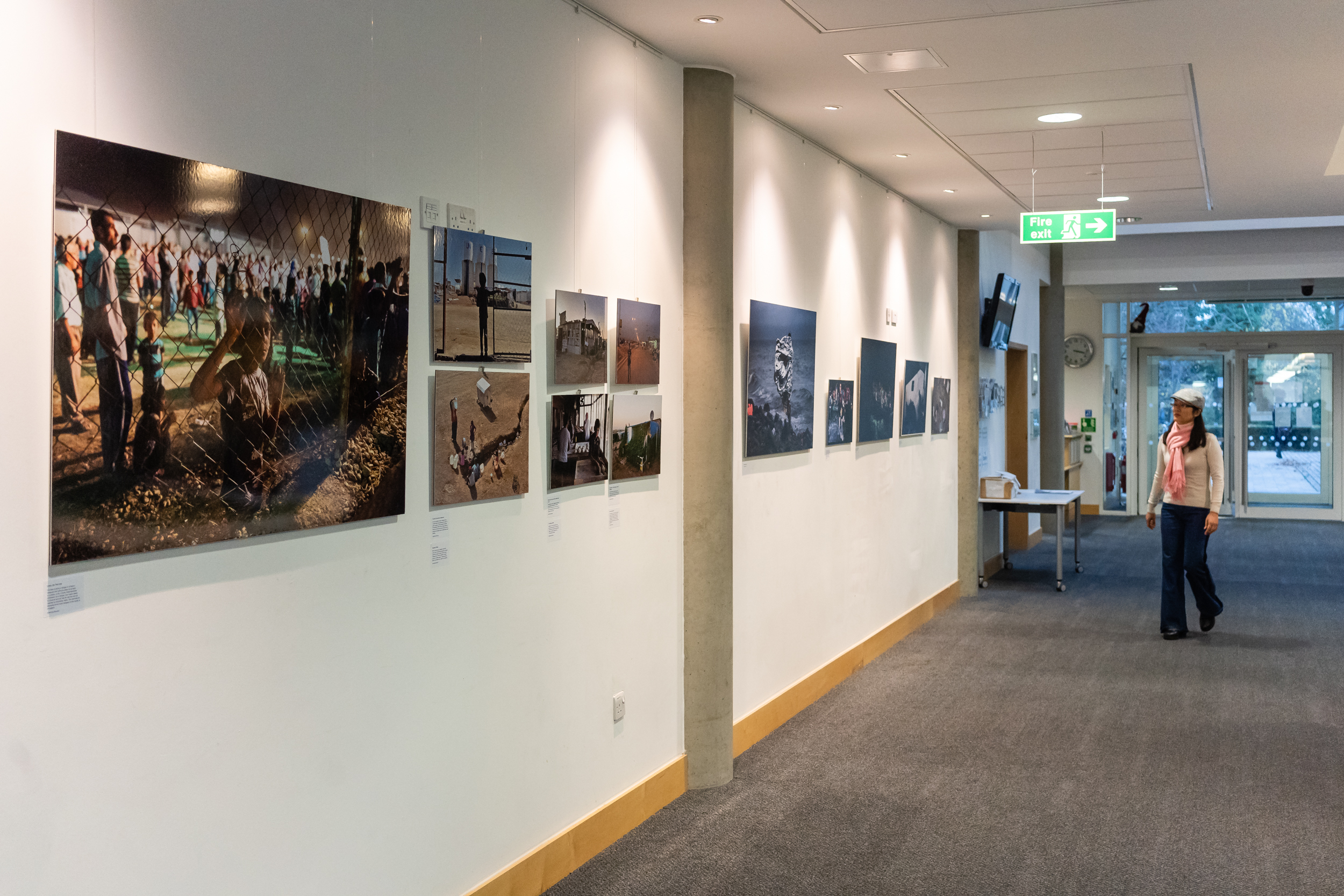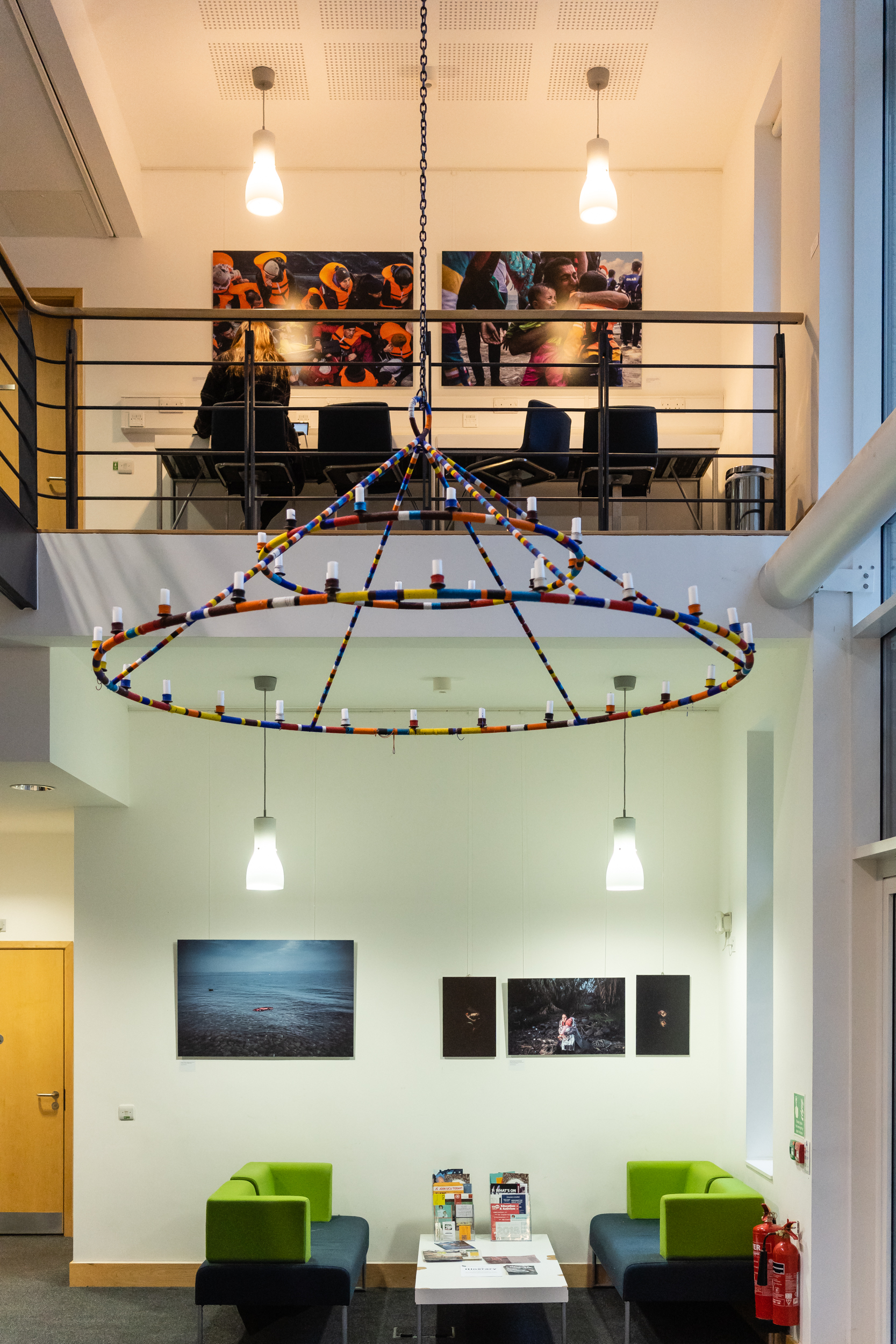Judith Weik, Coordinator of Art at the Alison Richard Building, speaks to some of the eleven photographers whose work is represented in the exhibition The Itinerary – Tracing the Refugee Routes. The exhibition is located on the ground, first, and second floors of the Alison Richard Building at the University of Cambridge and runs until 21 December 2018. Photographer biographies and further information about the exhibition can be found here: The Itinerary Exhibition. Installation photography by Orestis Seferoglou.

Q: What is The Itinerary exhibition about?
Orestis Seferoglou: The eleven photographers in this group traced the journey of refugees arriving from Turkey into Europe through Greece. The exhibition focuses on the different stopovers between their point of departure in the large-scale camps in Iraq, Syria, Lebanon and Sub-Saharan Africa, through Greece, and beyond to the so-called Balkan Route.
Anna Pantelia: All of the photographers come from different backgrounds, but we were documenting the same situation, each of us focusing on our personal perceptions of what we were witnessing.
Andrea Bonetti: Through my pictures, I wanted to show the huge importance of those people working behind the scenes – volunteers and others who are there 24/7 in order to help refugees find safety.
Q: How did you conceive the theme of this exhibition?
Anna Pantelia: Undoubtedly, media attention of the refugee crisis was already over-saturated by the time the decision for this exhibition was taken. But for us as photographers who live and work in Greece, we had the chance to spend some time following the stories of the people who became stuck in limbo. It was a chance for more in-depth reporting and this is what makes this exhibition particularly interesting.
Milos Bicanski: When more than a million refugees and migrants were passing through our country escaping war, our concern as a photo-journalist was how we could document the refugees’ circumstances. Their suffering, the deadly dangers they put their lives and children in, like crossing a sea in small dingy. We wanted to show the world that something is wrong, that this must be fixed as fast as it can be.
Andrea Bonetti: When I was photographing the arrivals of hundreds of rubber boats per day to the shores of Greek islands I realised that there was something really powerful going on in those dramatic moments. There were so many volunteers working to help refugees finding safety ashore, transforming those desperate moments into something so powerful and joyous. Refugees could feel so relieved once welcomed by all those warm people who were offering them warm clothes, food or just a big hug. The fear of the dangerous journey was over – at least for a moment.
Q: How did you interpret and work with the theme?
Anna Pantelia: I think this exhibition came at the right moment and in the right place. Greece, along with Italy, are the countries that have been burdened with this crisis the most. The exhibition was a decision taken after the EU-Turkey deal agreement that is totally inhumane and is based on trading human lives. Through our exhibition, we are trying to show the dangerous journey that people are taking in order to ensure a better life for themselves and their families. We show what children, women and men are going through for things that most of us have taken for granted.
Andrea Bonetti: When I take pictures that I really care about, I try to blend in with my surroundings, be it people or nature. I try to be as respectful as possible because I know how I would feel if I was on the other side of the lens. For my refugee story, I tried to work in a way that allowed me to be as much as possible in touch with my subjects, with respect for them as my first priority.
Orestis Seferoglou: I always try to search for the human side inside the events. I don’t want to see a refugee as something exotic or alien. Every person arriving on the shores of a Greek island or being stuck in a refugee camp brings with them a personal story. In many cases, this story might be the only thing keeping this person connected with their home. Through my images, I try to bring these stories in front of you.
Milos Bicanski: It was physically exhausting and painful. When I look back now at all photos I took on the Balkan Route, I can see that I subconsciously concentrated on mothers travelling alone with one or more children, most of them underage. It was probably because I believe that men are mostly the instigators of war but women and children suffer disproportionately.
Q: Apart from those interested in art/photography, who would this exhibition be of interest to?
Anna Pantelia: I believe this exhibition is for those interested in current affairs, those who want to learn more about the refugee journeys from the Middle East to central Europe.
Andrea Bonetti: Of course it should interest a wide public, because the issue of migration is a very old one, but ever more important today. Inequality and the climate crisis are becoming stronger year after year, the world is going to see more and more people moving away from their homes in search for a better livelihood. We are the lucky ones living in the rich world, what if we were on the other side? What would we do if our land was destroyed by bombs or if our soil would become so arid that we couldn’t grow our crops anymore? Unfortunately, the world is becoming a more difficult place to live for so many people. We have to become aware of that. And we have to help find solutions to make amends.
Louisa Gouliamaki: Literally Everybody! Those involved in social sciences, humanities, those who ever cared about those ordinary people on their extraordinary journeys …


